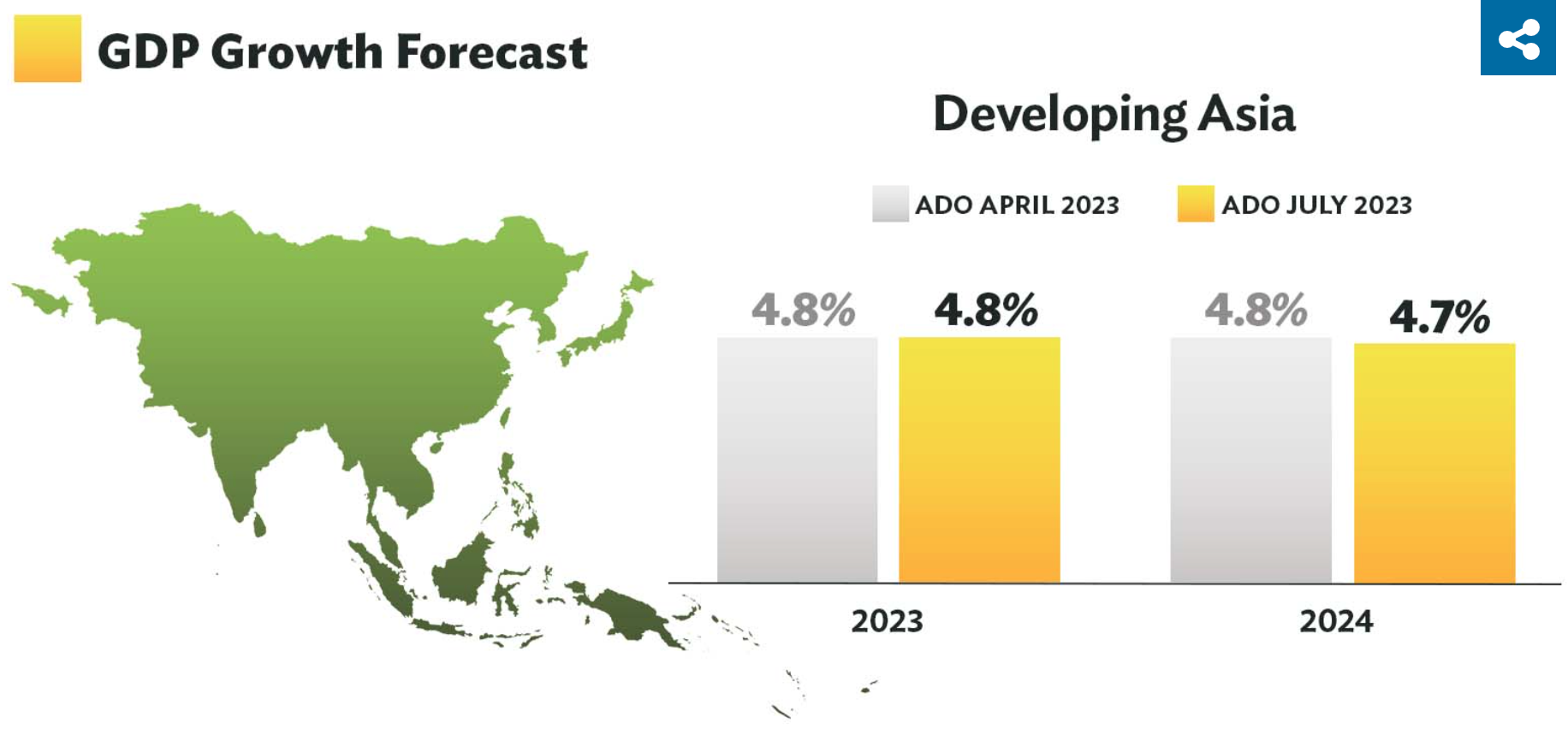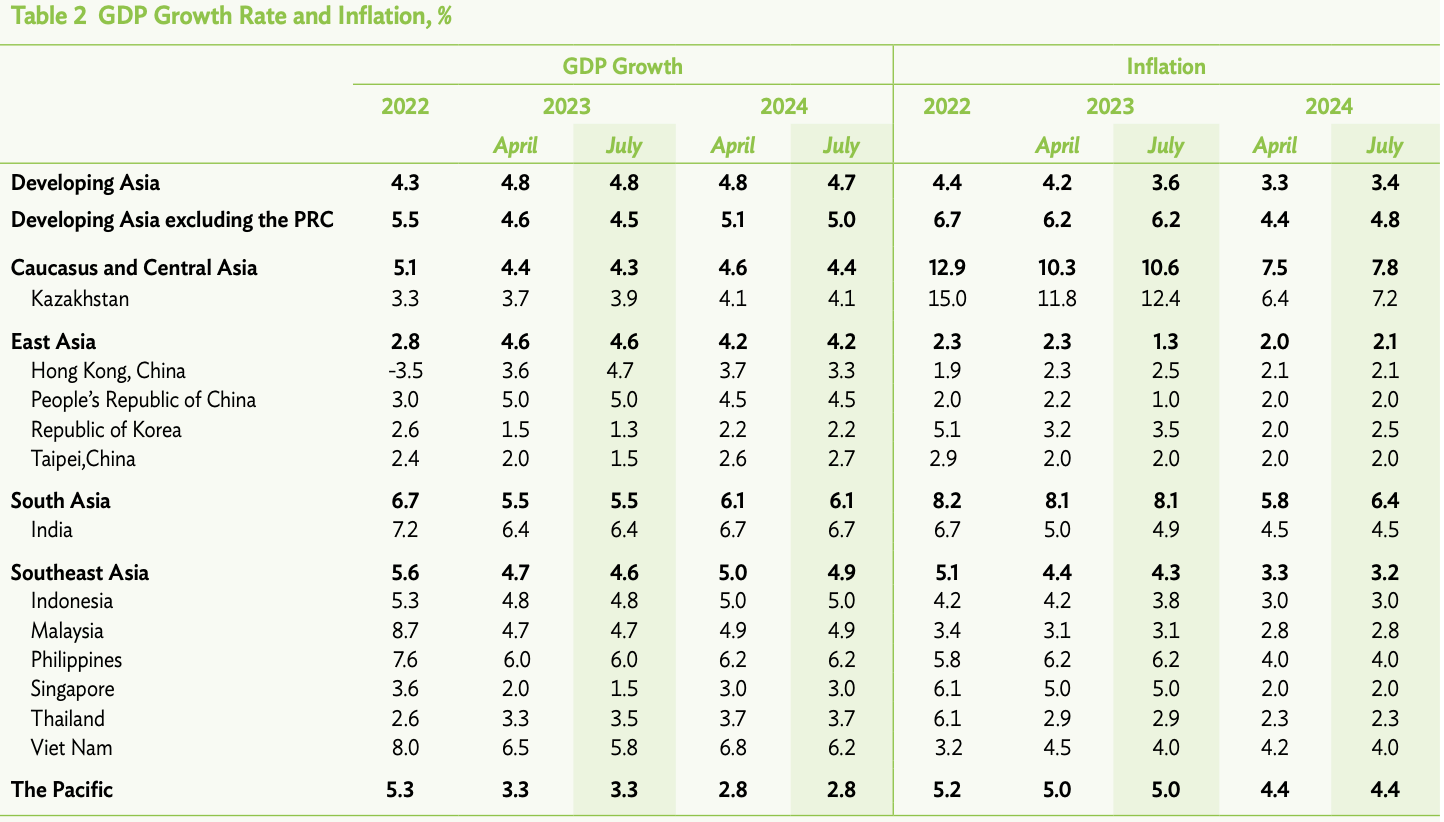ASTANA – Kazakhstan’s economy is projected to grow by 3.9% in 2023, according to the latest Asian Development Outlook report of the Asian Development Bank (ADB), an upward revision since its April forecast and up from 3.3% in 2022. The growth is driven by recovering industry, services, and domestic demand.

Established in 1966, ADB has 68 members, 49 from the region. Photo credit: ADB.
Kazakhstan is the largest economy in the Caucasus and Central Asia subregion.
“The upgrade accommodates higher growth in Q1 2023 and expanded domestic demand after budget revision in March added 10% to fiscal stimulus. GDP growth accelerated to 5% year on year in Q1 2023, with manufacturing increasing by 5.4% and services by 5.3%, reflecting sustained domestic demand. Private consumption will likely continue to accelerate as inflation slows and households enjoy higher real incomes,” reads the report.
Large infrastructure projects are forecasted to boost investment.
“Export growth will be buoyed by a gradual increase in oil output, which at 1.6 million barrels per day in April 2023 approached Kazakhstan’s quota under arrangements with other petroleum exporters. Improved demand from Kazakhstan’s trade partners will further support exports,” say experts.
Reporting on the economic indicators at a July 12 government meeting, Minister of National Economy Alibek Kuantyrov said the growth between January and June reached 5%, with all sectors showing an upward trend.
The construction sector observes the highest growth of 12.3%, followed by trade at 10.4%, and information and communication at 8.8%.

Caucasus and Central Asia comprises Armenia, Azerbaijan, Georgia, Kazakhstan, the Kyrgyz Republic, Tajikistan, Turkmenistan, and Uzbekistan. Photo credit: Screenshot from the ADO.
The growth projections for the Caucasus and Central Asia have been revised downward, decreasing from 4.4% to 4.3% for 2023 and from 4.6% to 4.4% for 2024 due to an unanticipated drop in oil production in Azerbaijan.
While the report revises forecasts for Kazakhstan, Georgia and Tajikistan, it will not be enough to realign the forecasts for Azerbaijan and Turkmenistan to mitigate the negative revisions.
Inflation in Kazakhstan will stand at 12.4% in 2023, expected to temper to 6.4% in April 2024 and 7.2% in July 2024.
“In Kazakhstan, external inflationary pressures eased, but tamping down inflation will be hampered by recently announced augmentation to expansionary fiscal policy in both 2023 and 2024,” reads the report.
President Kassym-Jomart Tokayev criticized the work of the government in December 2022, underlining staggering inflation of 20%. He tasked the government to halve the inflation by the end of the year.
Data from the Bureau of National Statistics indicate inflation hit 14.6% in June, down from 15.9% in May.
In terms of a broader outlook in Asia, domestic demand is expected to drive regional growth to 4.8% for 2023 and down only marginally to 4.7% for 2024.
The lifting of coronavirus restrictions in China contributes to the region’s economic recovery.
The Chinese economy is expected to grow by 5% this year, which remains unchanged from the previous forecast in April, primarily due to robust domestic demand in the services sector.
However, the demand for electronics and other manufactured goods from developing Asian countries is declining as major advanced economies implement monetary tightening measures, impacting overall economic activity.
“Asia and the Pacific continues to recover from the pandemic at a steady pace,” said ADB Chief Economist Albert Park. “Domestic demand and services activity are driving growth, while many economies are also benefiting from a strong recovery in tourism. However, industrial activity and exports remain weak, and the outlook for global growth and demand next year has worsened.”
Inflation is expected to continue falling, approaching pre-pandemic levels as fuel and food prices decline. Inflation in developing Asia is expected to reach 3.6% this year.
Kazakhstan was the first country in Central Asia to join ADB in 1994. Since then, the bank invested nearly $6 billion in the country. In May, ADB released a five-year country partnership strategy for Kazakhstan aimed at addressing climate change and decarbonization, promoting inclusive economic growth, and strengthening governance.
Energy, finance, public sector management, transport, and urban development are indicated as priority sectors by the ADB. The new strategy is aligned with Kazakhstan’s key strategic plans.

